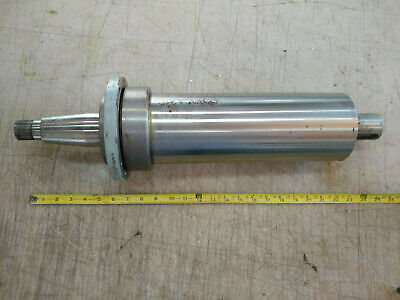- Joined
- Feb 5, 2018
- Messages
- 637
You can find those bearings on e. Bay if you do a little digging. I found a set of 7207's for my mill. They were about $160.
Joe
Joe
The spindle on my 1946 B&S 2L surface grinder is totally different from the ball bearing spindle your (and most other) surface grinders have. Mine has a shaft with a very slight taper on it of considerably large diameter, and a carefully matched housing. The special light oil required is the only thing that keeps them apart from each other aside from shimming the end play (IIRC, many years ago...) The setup and operation of it is done very carefully per the manual, and then it works incredibly well, very easy to get a beautiful finish on the work. I was skeptical at first, but it works quite well after 75 years...Spindle Parts
In order for me to be able to discuss this topic "semi intelligently" (not sure how to say this), here's a picture of the parts of the spindle. I'll use this as a reference when I don't know the names of the parts.
View attachment 387885
In your post #1, I thought that the picture of the end of the spindle was the grinding wheel hub end. From seeing your parts breakdown, maybe that's actually the motor coupling end??? Regardless, I would just measure the taper and lengths where the hubs mount and check whether you have right or left hand threads on the end of the shaft. You'll have to get either a right or left hand hub depending on the direction of spindle rotation.Good advice. I will be doing a lot more research before I get any bearings. I did look into Timken bearings just to get a sense of cost. I came across one of their reference manual which has an enormous amount of good information. Timken only because that's what came up when I was searching those numbers at a local web store. Local as a 2hr drive.
The wheel spindle does not look at all like the spindle in the B&S 2B parts book. I don't see any markings on the Spindle Bearing Sleeve. It does look like the original with a threaded hole for the oiler and optional one on the opposite side. I read somewhere that the oiler could be switched side.

Thanks Ted. I'll have to do some follow up on your comments.In your post #1, I thought that the picture of the end of the spindle was the grinding wheel hub end. From seeing your parts breakdown, maybe that's actually the motor coupling end??? Regardless, I would just measure the taper and lengths where the hubs mount and check whether you have right or left hand threads on the end of the shaft. You'll have to get either a right or left hand hub depending on the direction of spindle rotation.
There's good information here: http://www.lathes.co.uk/brown&sharpeno2grinder/
Also, check out vintagemachinery.org Go to Publication Reprints and see what manuals he might have there.
The oiler on my Pope spindle is on top of the housing and it is a drip type. It uses ball bearings, not a bronze split bearing.
Precision grinding spindles like these are really fussy to work on and assemble correctly. Just for a point of reference, you might want to look at prices for a replacement spindle cartridge, like my Pope. If you can find a good used one it might be another option for you.
Sopko http://www.wmsopko.com/ is the number one maker of grinding wheel hubs. They are NOT cheap. You mount a wheel on a hub and leave the wheel mounted typically. A different hub for each grinding wheel and they are mated until the grinding wheel is discarded.
There are a lot of people here on this site with grinders that can help. Just ask.
Ted
